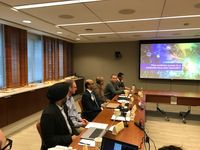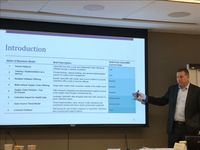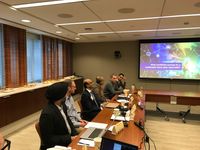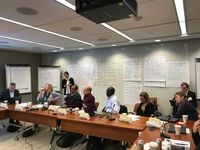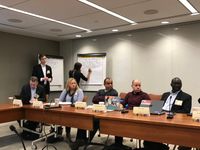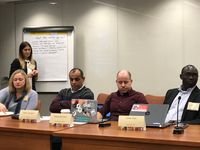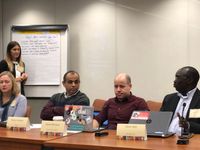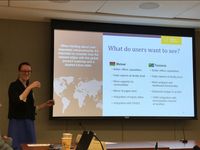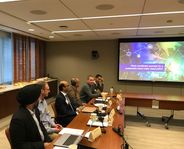For archiving documents, notes, and feedback from the Governance Committee on the OpenLMIS Sustainability work with Resonance
Final Deliverables and outputs from Resonance engagement:
| Name of Deliverable | Objective of deliverable | Link to deliverable file |
|---|---|---|
| Final Report and Recommendations (December 2019) | Provide a final summary of OpenLMIS future state options, observations/considerations, and recommendations for the stewards and community to move forward | OpenLMIS Sustainability Final Report Handover.pdf |
| Transition Planning- OpenLMIS Community Meeting | Facilitate community consensus around the exploration of future partnerships that can sustain the initiative, while adhering to core OpenLMIS principles. Particular focus on partnership opportunities with IQVIA and Mezzanine | 11.19 IQVIA Partnership Concept Note.pdf11.19 11.19 Mezzanine Overview for OpenLMIS.pdf11.19 |
| Transition Planning | Explore key elements to the OpenLMIS go-to-market strategy. Create a 1 page advocacy tool to use with future fundraising efforts as needed. Investigate potential of working with DIAL on the open-source center as part of our strategy. | 09.19 Go-To-Market Planning by Lenati.pptx1 0.19 OpenLMIS Fundraising Executive Summary Draft.docx11.19 |
Market Research- Private Health (Sept-Nov 2019) | Investigate the case for augmenting OpenLMIS to be used for private health customers. Use prototype to gague interest in potential private health customers | 07.19 Private Health Customer Interview Guide.docx09.19 OpenLMIS for Private Health Prototype Interview Guide.docx09.19 OpenLMIS for Private Health Prototype Presentation (VillageReach).pptx09.19 Private Health Market Sizing Information.xlsx10.19 Private Health Customer Profiling and Prototype Feedback.docx11.19 |
| Market Research- Agriculture Sector Viability Report | Explore the viability of using OpenLMIS core technology and applying it to the agricultural sector as a potential new market | OpenLMIS Sustainability_Agriculture Sector Viability Report_Sept 2019.pdf |
| Market Research- Country and Customer Segmentation | Explore revenue generating target markets, particularly LMICs, where OpenLMIS could capture market share | 06.19 Country and Customer Segmentation.pdf |
| Market Research- Market Sounding Visit Trip Report | Trip to Vietnam, South Africa, and Bangladesh to interview stakeholders (including current and potential partners) to 'pressure test' business models and discuss potential growth opportunities and partnerships. | 05.19 Market Sounding Trip Report.docx |
| Business Modeling (Sept-Nov 2019) | Explore blended financial models, potential approaches, considerations, cost modeling, and viability of these models to support OpenLMIS | 09.19 Financing Tools, Types, Outcomes & Impact.pdf10.19 Investors & Funders List & Questions Template.xlsx11.19 |
| Business Models-early stage (Jan 2019) | Assess OpenLMIS current state vs future state; community temperature check on high level business model options | |
| Foundational Research (Jan 2019) | Synthesize previous internal and external research on this topic, map current stakeholder roles & capabilities, define OpenLMIS Core attributes | 01.19 Stakeholder Interview Report.docx01.19 OpenLMIS Core Attributes and Early Business Model Ranking.pdf12.18 |
| Presentations made to the governance committee (throughout 2019) | To continually engage, update, and receive feedback from governance committee stakeholders throughout the process | 2019.02.12 - February GC meeting presentation.pptx 2019.04.16 - April GC meeting presentation.pptx 2019.05.21 - May GC meeting presentation.pptx June GC call - OpenLMIS Sustainability Update.pptx July GC call - OpenLMIS Sustainability Update.pptx August GC call - OpenLMIS Sustainability Update.pdf Sept GC Call - OpenLMIS Sustainability Update_ra_revised.pptx October GC Call - Slides pre-call.pptx |
OpenLMIS Community Meeting- Nov 18-20
This page contains all notes and materials from the 2019 Community Meeting in Johannesburg, where sustainability was a principal topic of discussion
Status Update and discussion re: Private Health Prototype Governance Committee - Oct 8, 2019
Materials:
Link to OpenLMIS Private Health Prototype (slide presentation in google slides): Private Health Prototype
Notes from the October Governance meeting are available here
Status Update & facilitated discussion with Governance Committee - September 10, 2019
Materials:
- ppt on Customer viability & future state planning 2) GTM-pricing strategy, licensing, and buyers 3) Financing tools, types, outcomes & impact
Meeting Notes: available here
Washington DC Meeting - January 29, 2019
In-person Attendees: Parambir S Gill (Unlicensed), Naomi Printz (Unlicensed), Lindabeth Doby, Craig Appl (Unlicensed), Brandon Bowersox-Johnson, Emily Bancroft, Chris Opit (Unlicensed), Ashraf, MAHMUDUL ISLAM (Unlicensed), Carl Leitner, Gaurav Bhattacharya (Unlicensed), Ramy Guirguis (Unlicensed), Kelly Hamlin (BMGF), David McCann (DIAL), Edward Wilson, Kaleb, Resonance Team
Virtual attendance: Josh Zamor, Wesley Brown, Mary Jo Kochendorfer (Deactivated), Rebecca Alban (Unlicensed), Alfred Mchau
Link to presentation recordings: https://www.dropbox.com/sh/ii9lfpjyigninqm/AACnWImgsq_rLFIDne61hY6ya?dl=0
Desired outcome for today: 2-3 new business models that they will continue to pursue in more depth. Prioritization process will follow
Sustainability Timeline: Second workshop will aim for May 15 or 16 to make final recommendations, June will be final product briefing
Summary notes and Meeting Powerpoint deck from Resonance:
Interview Report:
- Interviewed over 20 stakeholders to gain global perspective; in contrast to market-sounding visit which was for a specific country perspective
- Community-strong, invested community. Differing perspectives on definition on what sustainability means. Some felt that they want to be solution-agnostic but feel tied to OpenLMIS as something they are supposed to promote.
- Need to bring different value propositions to different audiences
- Customer- User experience and user requirements are not filtering up to the global level, and not integrated into product design. This is something that is desired in the future state. This presents a community perspective on the customer
- our current customer base is not going to be able to fund OpenLMIS sustainability
- example of customers paying for their own solution- TZ government funded the upgrade of their own ERP system
- Rwanda has gotten funding to do a OneNetwork implementation with Global Fund funds; Ghana is doing something similar.
- There are several instances of governments paying for software. But if its been free from the beginning it might be hard
- It's hard to identify the price-tag. Developing a total cost of ownership might help to avoid sticker shock (outlining cost for different ways it can be implemented)
- Donor perspective: shifting to global fund is not moving away from donors. We don't want to create dis-incentives. Make sure that all donors are aligned on their approach to make sure incentive structures all match
- Technology-
- Do we want OpenLMIS to succeed? or do we want an open-source suite of technology services succeed? If our goal is to support OpenLMIS, that is different than just wanting the services to be available. Is the goal to invest in this particular product or to service the end user? This will effect the business model discussion later in the day
- Consequence of an open source model is limiting centralized influence
- Deep customization in some implementations limits universal upgrades
- There is a lot of data that is being produced at the country level, that the global level cannot access
- Principle around that shared value statement- but there is no enforcement mechanism of that. That differs from the Logistimo model where they have a tighter hold over over those implementations
- Just because you are using a global tool doesn't mean that you will automatically get access to their data in country
- their data has value to the customers/suppliers of medicines and the OpenLMIS community. CHAI has been doing lots of drug access work/market shaping work and using demand data. This informs what the drug manufacturers need to manufacture–this transfers into cost savings–lower price on drugs and lower prices for countries
- Key question: What is the expected feedback loop between the countries/implementations and the global community so that we can move forward together? re: data, materials, input, etc.
- we need some of this data to improve the product. Big gap. How do we know its meeting client needs? Its hard to articulate that. We need to get access to user feedback, and we cant get google analytics data on this either
- Overview of funding streams for OpenLMIS
- 'Core' vs 'implementation' funding
- Review of Market-sounding trip in Malawi and Tanzania
- 24 stakeholder interviews saw eLMIS, VIMS, and v3
- very positive responses from users (contrast from global perspective)
- users want to see: better offline capabilities, facility-level data capture, integration with DHIS2
- How do we ultimately decide what gets built? What is most valuable user feedback? We are working in a resource constrained environment so we need to know what value proposition for these things? if something is so valuable for countries, would they be willing to 'pay' for it? Which user do we 'trust' to take their feedback? If software development starts to happen at a more local/regional level how do we differentiate feedback that we get?
- How does customer/user feedback get integrated into the new future state?
- As more instances come on board this will become more relevant:-- what is customization versus something that should be added to the core code? how to we strike this balance? this decision-making needs to feed into governance structure.
- Donors play as customer and a donor. They vet the product, support it to some extent. How do they play this dual role?
- concern in Tanzania about government 'selling' their data, strong ownership. The data is currently being shared to USAID
- Dissociation of who buys the product versus who is responsible for it. The client is not responsible for wastage, thus was not motivated to include it as a data point to capture. Its an important point that is not currently included.
- Framing Future State- develop list of desired attributes for future business models
- Is OpenLMIS strictly a health product for the public sector, or can it be expanded into the private sector, or other markets altogether?
- Ensure there is a local talent pool to support the solution- we assume this will lower the cost
- Focus on impact on supply chain efficiency–if you can link cost savings to OpenLMIS, governments will be more willing to pay (if you can tell them they will save money in the long run)
- Auditability-- ability to know who received what and when. We only see aggregates each month
- What is its core function? It streamlines the requisition and ordering process. This is structured very much to the public sector. We need to decide what pieces of this process that OpenLMIS would fit into. Is this the most important function? or could it be something more?
- OpenLMIS and its predecessors: facilitates ordering and requisitions, improve planning, provide visibility at the national level, (not warehouse management or transportation mgmt). It's a dumbed down version of One Network where you have lots more info to work with.
- Is there a point when OpenLMIS doesn't exist anymore because others have filled this need?
- Does this mean we are targeting less mature supply chains? do countries 'graduate' and move on to a more complex system. Is it for only LMICs? or should we look at Brazil and Latin America?
- Could there be a subsidy model, where there is a cost that reduces donor dependability. Have it be something else to other people (like a social enterprise)
- expressions of interest are not translating into implementations. There is eventually going to be a fiscal cliff from donors-not going to want to provide core funding anymore
- government funding is not enough to continue to maintain the product
Business models
- 8 different business models were discussed, and voted on at the end of the meeting to pursue further
- varying customers, other suppliers, expanding customer base
- varying revenue structure. Wanting to replace revenue 'stream A' (ie donors)
- changes to the product itself or the service you are offering
- one constant throughout all of the business models is that there is an OpenLMIS Inc
- we need to think through what the governance structure of OpenLMIS will be. Will it be 501c3?
- After voting, the business models that will be pursued further are:
- Partner Model
- Supply Chain Partners -Pay for Access
- Open Source Tiered Model
Pre-meeting materials circulated:
Photos
